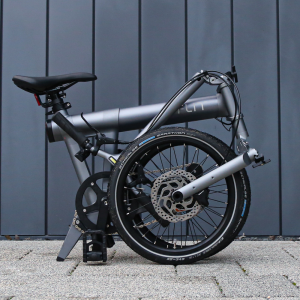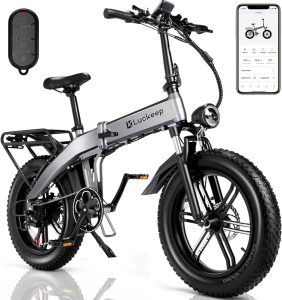The weight of a folding eBike typically ranges from 15 to 28 kilograms (33 to 62 pounds).
The Importance of Weight in Folding eBikes
When it comes to folding eBikes, the weight of the vehicle plays a critical role in its overall functionality and user experience. Heavier models might offer stability and durability, but can be cumbersome to carry, while lighter ones enhance portability but may compromise on other features.
Weight Considerations for Portability
Portability is a key selling point for folding eBikes, especially for commuters who may need to carry their bike on public transportation or up flights of stairs. The ideal folding eBike weight hovers around 12-15 kilograms (26-33 pounds), making it manageable for most people to lift without assistance. When the weight exceeds 20 kilograms (44 pounds), the eBike becomes less convenient to transport, especially if folding and unfolding are frequent activities.
Additionally, the ease of carrying a folding eBike is not just about weight—it’s also about the distribution of that weight. A well-designed eBike has a balanced center of gravity, which makes it easier to handle when folded.
For urban commuters, every kilogram counts. A folding eBike that combines a lightweight aluminum alloy frame with a compact lithium-ion battery can shave precious pounds off the total weight. The choice of materials is therefore a crucial consideration for manufacturers aiming to produce the most portable folding eBikes without compromising structural integrity or performance.
Impact of Weight on Performance and Range
The weight of a folding eBike also affects its performance, particularly in terms of acceleration, hill-climbing ability, and range. Generally, a lighter eBike will consume less energy to move, translating to more miles per charge. For example, a folding eBike that weighs 15 kilograms with a 250-watt motor might achieve a range of 60 kilometers (37 miles) on a single charge, while a heavier model, say 20 kilograms, might only reach 45 kilometers (28 miles) under similar conditions.
It’s not just the distance; speed is also a consideration. Lighter eBikes typically have quicker acceleration due to the reduced mass the motor has to propel. For riders looking for swift urban transit, a model that can reach a maximum speed of 25 kilometers per hour (15.5 miles per hour) without excessive power drain is desirable. The key here is to balance the weight with the motor’s power output, ensuring efficiency does not come at the cost of performance.
Finally, when considering the lifespan of the eBike, weight again plays a significant role. Heavier eBikes put more strain on components such as brakes and tires, potentially leading to more frequent replacements and increased long-term maintenance costs.
Average Weight of Folding eBikes
The average weight of folding eBikes can significantly influence a rider’s decision, particularly when comparing them to non-folding eBikes and traditional bicycles.
Comparison to Traditional Bicycles and eBikes
Traditional bicycles typically weigh between 9 to 13 kilograms (20 to 29 pounds), depending on the material and size. On the other hand, standard eBikes are considerably heavier due to their motor and battery, weighing on average between 18 to 29 kilograms (40 to 64 pounds).
Folding eBikes strike a middle ground in this spectrum. On average, folding eBikes weigh approximately 14 to 20 kilograms (31 to 44 pounds). This weight includes the battery and motor, yet remains low enough to maintain the portability that folding bikes promise. The added weight over traditional bicycles comes from the electrical components, but it is less than non-folding eBikes due to the necessity of keeping folding bikes as lightweight as possible for ease of transport and storage.
Weight Ranges of Popular Folding eBike Models
When we delve into the specifics, popular folding eBike models show a range in weight that reflects their varied components and design choices:
- Entry-level folding eBikes might weigh around 18 kilograms (40 pounds) and carry a modest price tag of approximately $1,000.
- Mid-range models often weigh closer to 16 kilograms (35 pounds) and have prices around $1,500, balancing cost with improved features such as lighter materials or more efficient batteries.
- High-end folding eBikes, which prioritize lightweight materials like carbon fiber and advanced lithium batteries, can weigh as little as 12 kilograms (26 pounds) but may cost upwards of $2,000.
The motor’s power output typically stands at 250 watts for these folding eBikes, adhering to the legal limitations in many regions and offering a balance between speed, which tops out at 25 kilometers per hour (15.5 miles per hour), and efficiency in battery use.
Consumers often have to consider the trade-off between a lighter weight and the cost, as the technologies that reduce the weight of the eBike, like carbon fiber frames or high-capacity yet light batteries, come at a premium. Additionally, the dimensions of the eBike when folded also contribute to its practicality; more compact designs may sacrifice some features, such as larger wheels, to maintain a lower weight and smaller size when folded.
In terms of quality, brands like Brompton and Tern have become synonymous with high-quality folding eBikes, often cited for their robust construction and ease of folding, while maintaining weights that fall within the average range for folding eBikes.
Factors Influencing the Weight of Folding eBikes
Several factors contribute to the weight of folding eBikes. Manufacturers must consider each element to meet the ideal balance between functionality and portability.
Frame Materials and Construction
The frame is the backbone of any eBike, and its material significantly impacts the overall weight. Aluminum is the most common material used in folding eBike frames due to its light weight and strength. An aluminum frame can weigh approximately 3 kilograms (6.6 pounds), whereas a steel frame might weigh around 5 kilograms (11 pounds) or more. High-end folding eBikes sometimes use carbon fiber to further reduce weight, often bringing the frame weight down to around 2 kilograms (4.4 pounds).
The construction method also plays a role. Hydroformed aluminum frames, which are shaped using a high-pressure hydraulic fluid, can offer strength where it’s needed while saving weight in other areas. For instance, hydroforming can reduce frame weight by up to 10% compared to traditional aluminum frames.
Battery Size and Type
Batteries are a substantial part of an eBike’s weight. A standard lithium-ion battery for a folding eBike might weigh between 2.5 to 3.5 kilograms (5.5 to 7.7 pounds), depending on the capacity. The energy content of the battery, measured in watt-hours (Wh), directly relates to its size and weight. For instance, a 300Wh battery might weigh less than a 500Wh one, but it would also offer a shorter range.
Manufacturers must balance the desire for longer ranges with the need for lighter weights. The cost is also a factor; higher-capacity batteries increase both the weight and the price of the eBike.
Motor Specifications
The motor adds to the weight of a folding eBike, with most motors weighing between 1.5 to 3 kilograms (3.3 to 6.6 pounds). The power of the motor, measured in watts, doesn’t always correlate with weight. For example, a 250-watt motor that’s common in many folding eBikes might weigh roughly the same as a more powerful 350-watt motor, due to differences in motor construction and materials.
Efficiency is a key consideration here; a more efficient motor can provide the same power with less weight, but these motors may increase the cost.
Additional Features and Accessories
Every additional feature and accessory on a folding eBike will contribute to its weight. Standard accessories like lights, fenders, and racks can add up to an additional 1 kilogram (2.2 pounds). More advanced features, such as electronic gear shifters or integrated GPS systems, will also add weight, though usually less than 0.5 kilograms (1.1 pounds) for each feature.
Manufacturers must consider which features are essential and how they impact the overall weight. For many riders, the convenience of certain features outweighs the slight increase in weight they bring.
How to Choose the Right Folding eBike Weight for You
Selecting the appropriate folding eBike involves considering its weight in the context of how you will use it, what you can physically manage, and the performance you expect.
Considerations for Commuting and Travel
When you’re using a folding eBike for commuting, think about the distance you will travel and the ease with which you can carry the bike. If you need to lift the bike frequently, such as when using public transportation or navigating stairs, look for a model that weighs less than 15 kilograms (33 pounds), which is manageable for most people to lift without strain.
For those who commute longer distances, the eBike’s range becomes crucial. A battery with at least 300Wh can offer a range of up to 40 kilometers (25 miles) on a single charge, but remember, larger batteries increase the weight. You must weigh the convenience of fewer charges against the added weight.
If your travel involves air transport, airlines have strict regulations regarding the transport of batteries. Batteries over 160Wh may not be allowed, or they may require special handling, which can add to your travel time and stress.
Balancing Weight with Durability and Range
Durability is often associated with the sturdiness of construction, which can add weight. An eBike made for rugged terrain with reinforced frames and components might weigh more but will withstand the demands of off-road use.
You’ll also need to balance the eBike’s weight with the range you require. If a long range is essential, you’ll need a larger battery, which will increase the weight. For example, an eBike with a 500Wh battery can offer a range of up to 70 kilometers (43.5 miles), but it may push the weight closer to 20 kilograms (44 pounds).
For some riders, the trade-off for a heavier but more durable bike is worth it, especially if they place a high value on longevity and quality.
Personal Weight Limitations and Comfort
Your strength and physical condition are important considerations. A heavier bike will be more difficult to maneuver, especially for those with limited strength or mobility. Assess your personal weight limitations and choose an eBike that you can comfortably lift and carry.
Comfort also extends to the bike’s operation. A heavier eBike might have more stability at higher speeds, which can be a comforting feature for some riders. Conversely, a lighter bike can feel nimbler, which might suit urban riders who navigate through traffic and tight spaces.
When considering comfort, also think about the eBike’s folded dimensions. If storage space is limited, a more compact model, which might also be lighter, will be more appropriate.


